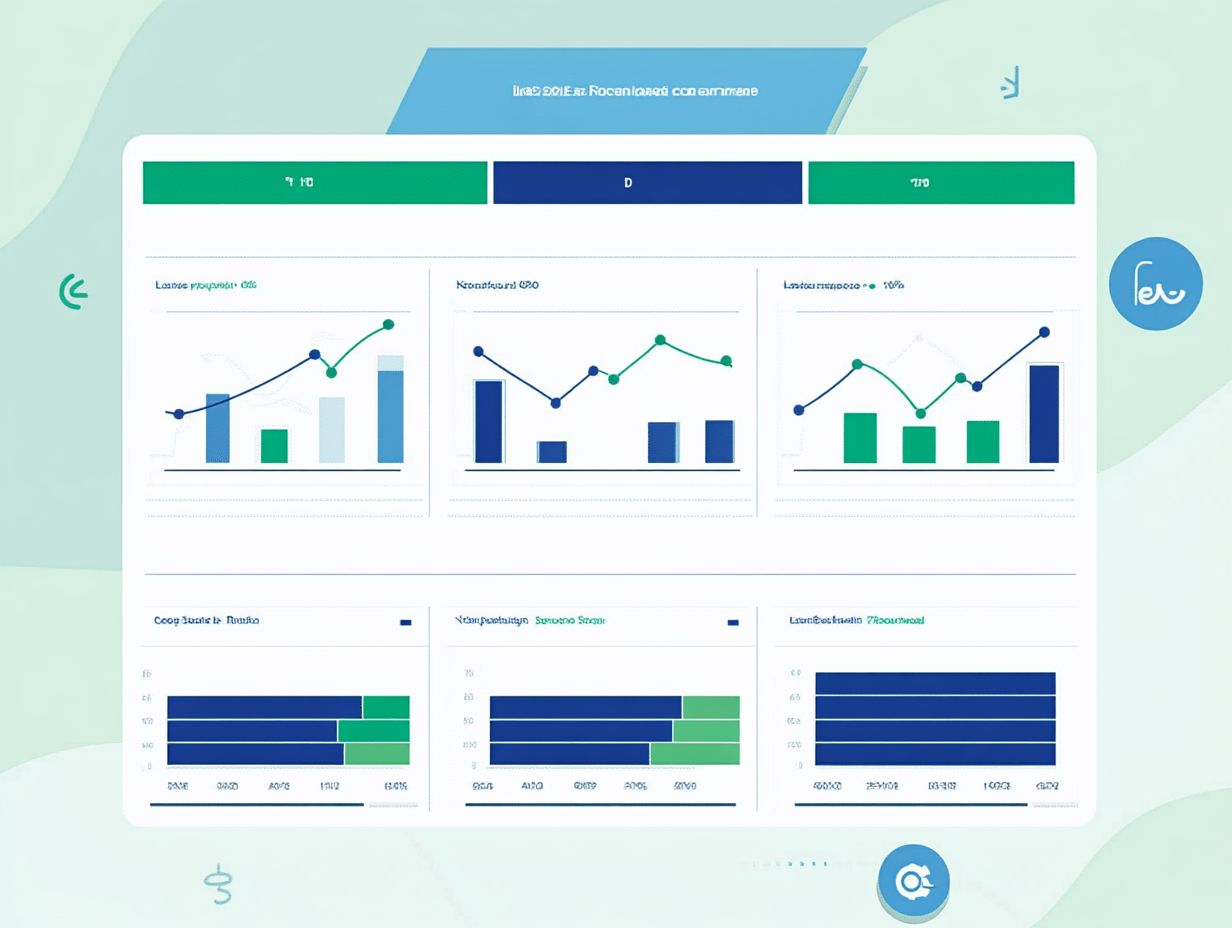7 Metrics to Track in Your Lead Management System
Let's Set Up Your Lead Generation Strategy
Fill out the form below, and our team will get in touch with you to create a tailored solution for your business.
In today’s fiercely competitive landscape, mastering effective lead management is essential for businesses aiming to thrive. Understanding the intricacies of lead generation can give you a significant edge.
But how can you measure success in this critical area? This article delves into seven key metrics and KPIs that shed light on the effectiveness of your lead management system.
From the sheer number of leads generated to the all-important customer acquisition cost, each metric is unpacked with precision to highlight its significance.
You’ll discover tools to track these metrics, including Google Analytics and Similarweb, tackle common challenges, and implement strategies for continuous improvement.
Join us on this exciting journey to navigate the vital components of lead management that can empower your business decisions and drive your success forward, particularly through effective sales process optimization.
Contents
- Key Takeaways:
- 1. Number of Leads Generated
- 2. Lead Conversion Rate
- 3. Cost per Lead
- Let's Set Up Your Lead Generation Strategy
- 4. Time to Contact
- 5. Lead Response Time
- 6. Lead Quality
- 7. Return on Investment (ROI)
- Let's Set Up Your Lead Generation Strategy
- What Is Lead Management and Why Is It Important?
- Let's Set Up Your Lead Generation Strategy
- Frequently Asked Questions
- Let's Set Up Your Lead Generation Strategy
Key Takeaways:

- Track the number of leads generated to determine the success of your marketing strategies and website traffic effectiveness.
- Measure lead conversion rate to understand the effectiveness of your sales process.
- Keep track of customer acquisition costs to optimize your marketing budget and improve your return on investment.
1. Number of Leads Generated
The number of leads you generate is a crucial metric in the lead generation landscape, significantly influencing your overall sales process. It offers valuable insights into the effectiveness of your marketing strategies and the potential for future customer acquisition.
A strong lead tracking system helps you monitor the growth of your lead database and assess the quality of leads coming from various channels, such as organic website traffic and social media engagement.
To enhance your lead generation efforts, you have a wealth of marketing strategies at your disposal. These include content marketing, email campaigns, and pay-per-click advertising. Each of these approaches plays a vital role in attracting potential customers and guiding them through the sales funnel.
Metrics and important metrics that measure success, such as lead source effectiveness, are essential for analyzing which channels deliver the best results. This data highlights your successful tactics and informs your future decisions, enabling you to allocate resources more efficiently and ultimately refine your lead generation strategies.
2. Lead Conversion Rate
The lead conversion rate serves as a crucial benchmark for how effectively you turn leads into customers during the sales cycle. It reflects the strength of your lead generation and qualification processes.
Grasping this metric is essential for any business looking to fine-tune its approach. High-quality leads—those with clear intent and a strong alignment with your product or service—typically result in better conversion rates. The effectiveness of your sales techniques is also a key factor; personalized outreach and timely follow-ups can significantly boost your chances of converting leads.
To gauge success, tracking important metrics such as the conversion rate, average deal size, and lead response time can provide invaluable insights.
To enhance your conversion rates, consider implementing strategies like tailored content, nurturing campaigns, and ongoing training for your sales teams. These efforts can create a more engaging experience for potential customers, making it easier for them to say “yes.”
3. Cost per Lead
Understanding the cost per lead is crucial for you to evaluate the customer acquisition costs tied to different marketing strategies and gauge the overall return on investment (ROI) from your lead generation efforts.
Let's Set Up Your Lead Generation Strategy
Fill out the form below, and our team will get in touch with you to create a tailored solution for your business.
This metric offers invaluable insights into the effectiveness of various channels, revealing where your resources can be best allocated for maximum impact. You need to assess how each marketing avenue—be it email marketing, social media campaigns, or paid advertising—affects your cost per lead.
By analyzing these results, you can make informed decisions about budget reallocations and optimize your marketing expenditures. Implementing tracking tools and metrics is essential for identifying high-performing channels, ultimately enhancing your overall efficiency and driving more favorable financial outcomes.
With these metrics in hand, you can transform your lead management strategy. Start tracking today to unlock the full potential of your business!
4. Time to Contact
Time to contact refers to the duration between generating a lead and making that crucial first interaction with a potential customer. This interval significantly influences both evaluating leads and overall sales effectiveness.
Responding swiftly to inquiries shows that you’re attentive and signals a genuine commitment to customer satisfaction. In the fast-paced world of sales, leads can lose interest or turn to competitors in the blink of an eye if they’re not engaged promptly. That’s why it’s vital for your business to act quickly and adopt effective strategies to minimize this critical interval.
Setting up automated alerts in your CRM software is a best practice. This allows you to track leads in real-time and streamline your outreach efforts. Regularly analyzing response metrics enables you to make necessary adjustments that enhance performance. This proactive approach fosters a more responsive sales environment and boosts your lead conversion rates.
5. Lead Response Time

Lead response time is a crucial element in assessing lead quality and significantly impacts your overall sales process. When you respond quickly, you enhance your chances of achieving higher conversion rates and improving the lead-to-customer conversion ratio.
Research shows that leads contacted within minutes are far more likely to engage and convert than those left waiting for hours or even days. For your sales team, this means it’s essential not just to aim for timely follow-ups but also to measure performance through relevant metrics like response time, conversion rates, and customer acquisition costs.
By analyzing these key performance indicators, you can identify where delays occur and fine-tune your strategies. Implementing sales intelligence tools and automation can help streamline this process, enabling your team to respond instantly or prioritize leads effectively, ensuring that no opportunity slips through the cracks.
6. Lead Quality
Lead quality is key to your lead generation process. High-quality leads match your ideal customer profile and can lead to faster sales and greater customer value.
To evaluate lead quality effectively, implement a well-defined qualification process using criteria like engagement level, demographic fit, and buying intent. These factors help you pinpoint which prospects are most likely to convert into loyal customers.
By measuring lead quality through key performance indicators like conversion rates, lead scoring, and return on investment, you can refine your marketing strategies. This approach maximizes your resource allocation and sharpens your targeting precision, allowing you to focus on leads that offer the greatest potential for profitability.
7. Return on Investment (ROI)
Calculating the return on investment (ROI) for your lead generation activities is essential for understanding how effective your marketing strategies are and how they influence customer acquisition costs within the sales process.
By analyzing components like the total costs associated with these activities—such as advertising expenditures, resource allocation, and time investments—you gain invaluable insights into your financial performance. Lead generation enhances your sales metrics and key performance indicators (KPIs) by providing a consistent flow of potential customers that you can nurture through the sales funnel.
Let's Set Up Your Lead Generation Strategy
Fill out the form below, and our team will get in touch with you to create a tailored solution for your business.
These insights enable you to refine your marketing tactics, allowing for smarter budget allocation and improved overall sales efficiency.
What Is Lead Management and Why Is It Important?
Lead management is your systematic approach to acquiring, tracking, and nurturing leads throughout the sales process. This ensures that you engage potential customers effectively while optimizing their journey to reduce customer acquisition costs and maximize conversion rates.
Various components support this process, including strong tools to track leads that monitor interactions and behaviors. This enables your sales team to identify and prioritize high-quality leads.
Integral to lead management are Customer Relationship Management (CRM) software tools, which help you organize and analyze customer data, streamline communication, and enhance follow-up strategies.
By effectively implementing these tools, you can maintain the quality of your leads and elevate your overall sales performance metrics. Consequently, these systems are essential for shaping your sales strategies, enabling your sales team to tailor their approaches based on valuable insights gleaned from lead data.
How Can Tracking These Metrics Help Improve Lead Management?
Tracking metrics and KPIs is vital for enhancing your lead management efforts, as it provides actionable insights that can streamline your sales process and elevate the effectiveness of your lead generation strategies.
By honing in on key performance indicators like lead conversion rates, average response times, and cost per lead, you can assess the health of your sales pipeline. Sales intelligence tools integrated with your CRM software enable you to effortlessly capture these metrics, granting you real-time visibility into lead interactions and behaviors.
This data-driven approach simplifies lead tracking and informs your decisions. This enables you to allocate resources more effectively and refine your outreach efforts based on what has worked in the past.
Ultimately, tapping into these insights can significantly enhance your overall performance and drive impressive revenue growth.
What Tools Can Be Used to Track These Metrics?

Various tools, including CRM software and sales intelligence platforms, can be leveraged to track essential metrics related to lead tracking, ultimately elevating the effectiveness of your lead generation and sales strategies.
Platforms like Google Analytics provide invaluable insights into website traffic and user behavior, allowing you to grasp how well your marketing efforts are performing. By integrating UTM parameters into your campaigns, you can obtain precise information about which sources are driving leads and conversions.
This data helps in formulating more targeted marketing strategies and aids in optimizing your funnel processes.
Over time, these insights will enable you to make informed decisions, leading to a greater return on investment. Therefore, combining these tools is vital for any organization aiming to refine its lead management approach. Start optimizing your lead management today!
How Can a Business Use These Metrics to Make Informed Decisions?
You can leverage metrics and KPIs to make informed decisions that enhance your lead management, optimize the sales process, and improve customer acquisition costs—all in pursuit of a higher return on investment.
Let's Set Up Your Lead Generation Strategy
Fill out the form below, and our team will get in touch with you to create a tailored solution for your business.
By systematically analyzing the data you’ve collected, you’ll be able to identify patterns and trends that reveal hidden opportunities for growth. For example, a prominent software company took a closer look at their conversion rates and discovered that certain channels were yielding higher quality leads. As a result, they recalibrated their marketing strategies to focus more on these high-performing sources.
Another compelling case comes from a retail brand that made metrics-driven decisions based on customer behavior data. By optimizing their inventory according to buying trends, they saw a significant boost in sales outcomes.
These case studies underscore the importance of adopting a metrics-centric approach to drive successful lead generation initiatives.
What Are the Common Challenges in Tracking These Metrics?
Tracking metrics and KPIs can be quite the uphill battle, presenting challenges like ensuring data accuracy and managing lead quality throughout the sales process. These hurdles can severely hinder your lead management and strategic decision-making.
Many businesses face data integration issues when their CRM software fails to synchronize information across various platforms. This disjointed data can create confusion and misinterpretation, ultimately affecting your promotional strategies and customer engagement.
To navigate these obstacles, consider implementing robust data integration tools that streamline information flow. Encouraging regular data reviews will enhance accuracy and reliability, enabling your teams to make informed decisions that align with your strategic objectives.
How Can a Business Continuously Improve Their Lead Management System?
Continuous improvement of your lead management systems is crucial if you’re aiming to enhance lead tracking, refine your marketing strategies, and elevate overall efficiency within the sales process.
By adopting a systematic approach, you can routinely assess your metrics and key metrics to pinpoint areas that require enhancement. This ongoing evaluation shows how well your current strategies work and highlights new opportunities to optimize lead conversion.
Staying attuned to market changes and responsive to customer feedback enables you to pivot and adapt your approaches. This ensures your lead management system remains relevant and effective in meeting both customer needs and your organizational goals.
Frequently Asked Questions
1. What are the 7 metrics that should be tracked in a lead management system?

The 7 metrics that should be tracked in a lead management system are:
- Lead generation rate
- Conversion rate
- Lead response time
- Lead follow-up rate
- Lead qualification rate
- Lead to customer ratio
- Cost per lead
2. How can tracking lead generation rate help improve my company’s sales?
Tracking lead generation rate can help identify which marketing strategies are bringing in the most leads. This allows you to focus resources on the most effective methods and increase overall sales.
3. What is the importance of monitoring lead response time?
Monitoring lead response time is crucial. Studies have shown that the faster a lead is contacted, the more likely they are to convert into a customer. It can also help identify any bottlenecks in the lead follow-up process.
4. How does tracking lead follow-up rate impact the success of my lead management system?
Tracking lead follow-up rate can help ensure that no potential leads are slipping through the cracks. It also allows for analysis of follow-up methods and adjustments to improve overall response rates.
Let's Set Up Your Lead Generation Strategy
Fill out the form below, and our team will get in touch with you to create a tailored solution for your business.
5. In what ways can monitoring lead qualification rate benefit my company?
Monitoring lead qualification rate can help identify the quality of leads being generated. This allows for adjustments in targeting and lead nurturing strategies, ultimately leading to a higher conversion rate and increased ROI.
6. Ever wondered why measuring your lead to customer ratio is vital? Let’s find out!
Measuring lead to customer ratio helps determine the effectiveness of the lead management system in converting leads into customers. It also provides insight into the overall sales process and areas for improvement.






